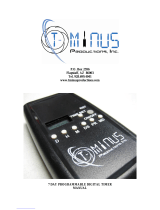
13
12 Lightning — If a lightning storm occurs while using the optional AC
adapter, unplug the adapter power cord from the wall outlet
immediately. To avoid damage from unexpected power surges,
always unplug the AC adapter from the power outlet and disconnect
it from the camera when the camera is not in use.
13 Overloading — Never overload wall outlets, extension cords, power
strips, or other power connection points with too many plugs.
14 Foreign Objects, Spillage — To avoid personal injury from fire or
electrical shock from contact with internal high voltage points, never
insert a metal object into the product. Avoid using the product
where there is a danger of spillage.
15 Servicing — Refer all servicing to qualified personnel. Attempting to
remove the covers or disassemble the product, could expose you to
dangerous high voltage points.
16 Damage Requiring Service — While using the optional AC adapter,
if you notice any of the conditions described below, unplug the AC
adapter from the wall outlet and refer servicing to qualified service
personnel:
a) If liquid has been spilled, or any object has fallen into the
product.
b) If the product has been exposed to water.
c) If the product does not operate normally while following
operating instructions. Adjust only the controls described in the
operating instructions as improper adjustment of other controls
could damage the product, requiring extensive repair work by a
qualified technician to restore the product to normal operation.
d) If the product has been dropped or damaged in any way.
e) If the product exhibits a distinct change in performance, this
indicates a need for servicing.
17 Replacement Parts — When replacement parts are required, make
sure that the service center uses only parts recommended by the
manufacturer to ensure that the replacement parts have the same
characteristics as the originals. Unauthorized substitution of parts
could cause a fire, electrical shock, or create other hazards.
18 Safety Check — Upon completion of servicing or repairs, ask the
service technician to perform safety checks to determine that the
product is in good working condition.
19 Heat — Never use or store this product near a heat source such as
a radiator, heat register, stove, or any type of equipment or
appliance which generates heat, including stereo amplifiers.






















